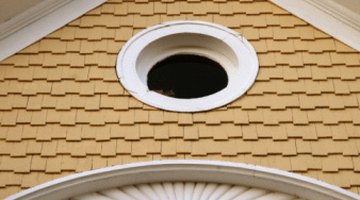How to Remove Mildew From the Eaves of My House
Because eaves are unheated, moisture tends to condense there, promoting mold and mildew growth. Left untreated, mildew may cause the wood to eventually rot. To minimize mildew growth, fix any leaks in the rain gutters and trim back trees so they don't brush directly against the eaves of the house.

Things You Will Need
- 1 qt. chlorine bleach
- Bucket
- Sponge
- Scrub brush
- Sturdy ladder
- Enamel paint with mildewcide
- Mildew-resistant additive
Install small vents under the eaves to remove moisture from unheated attics. Remove any mildew at least annually, as part of spring or fall cleaning.
-
Place a drop of chlorine bleach on the surface to determine if the stain is mildew or dirt. Wait five minutes. If the stain fades, it is mildew. If it remains the same, it is likely dirt or rust.
-
Mix 1 qt. chlorine bleach with 3 qt. warm water in a bucket. While standing on a sturdy ladder, apply the bleach solution to the stains with a sponge. Wait 20 minutes. Scrub the surface with a scrub brush to remove all signs of mildew.
-
Rinse the surface with a sponge dipped in clean water. Allow the eaves to dry for 24 hours. Re-paint them with a glossy, enamel paint. Use a paint with a mildewcide, or mix the paint with a mildew resistant additive. Paint surfaces on dry, windless days.
Tip
Darkly colored paints dry more quickly, resisting mildew better than light paint, according to This Old House. Latex paints also inhibit mildew more readily than oil paints. Wear rubber gloves and goggles to avoid eye and skin irritation.
References
Tips
- Darkly colored paints dry more quickly, resisting mildew better than light paint, according to This Old House. Latex paints also inhibit mildew more readily than oil paints.
- Wear rubber gloves and goggles to avoid eye and skin irritation.
Writer Bio
Julie Christensen is a food writer, caterer, and mom-chef. She's the creator of MarmaladeMom.org, dedicated to family fun and delicious food, and released a book titled "More Than Pot Roast: Fast, Fresh Slow Cooker Recipes."
Photo Credits
- Jupiterimages/Photos.com/Getty Images
- Jupiterimages/Photos.com/Getty Images
More Articles



